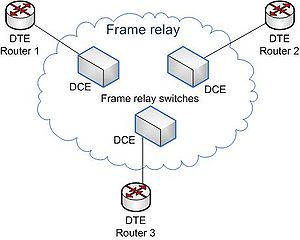Objective 2.5: Wide Area Networks
Objective 2.5: Categorize WAN technology types and properties
You can connect more than one Local Area Network (see Objective 2.6) together with a router to form a Wide Area Network (WAN). Many companies who have multiple buildings may connect them together to form a WAN. A WAN can be any scope, but when it is in a group of buildings in the same geographical location, it is sometimes called a CAN, or Campus Area Network. If it spans a larger geographic area, such as an entire city, like a local government may have, it is called a MAN, or Metropolitan Area Network.
Note: This is just for simplicity's sake. Technically, there are more differences than just size and scope between a MAN, a CAN, and a WAN, like communication standards, but these differences are beyond the scope of the Network+ Exam.

In the context of computer networking, frame relay consists of an efficient data transmission technique used to send digital information. It is a message forwarding "relay race" like system in which data packets, called frames, are passed from one or many start-points to one or many destinations via a series of intermediate node points.
Network providers commonly implement frame relay for voice and data as an encapsulation technique, used between Local Area Networks over a Wide Area Network. Each end-user gets a private line (or leased line) to a frame-relay node. The frame-relay network handles the transmission over a frequently-changing path transparent to all end-users.
The designers of frame relay aimed at a telecommunication service for cost-efficient data transmission for intermittent traffic between local area networks and between end-points in a wide area network. Frame relay puts data in variable-size units called "frames" and leaves any necessary error correction (such as retransmission of data) up to the end points. This speeds up overall data transmission. For most services, the network provides a PVC (Permanent Virtual Circuit), which means that the customer sees a continuous, dedicated connection without having to pay for a full-time leased line, while the service provider figures out the route each frame travels to its destination and can charge based on usage.
Frame relay relays packets at the data link layer (layer 2) of the OSI (Open Systems Interconnection) model rather than at the network layer (layer 3).
- Speed: Frame relay complements and provides a mid-range service between basic rate ISDN (Integrated Services Digital Network), which offers bandwidth at 128 kbit/s, and ATM (Asynchronous Transfer Mode), which operates in somewhat similar fashion to frame relay but at speeds from 155.520 Mbit/s to 622.080 Mbit/s.
- Packet switched
- Speed: 2.048 Mbit/s (E1) and 1.544 Mbit/s (T1)
- Speed: 34.368 Mbit/s (E3) and 44.736 Mbit/s (T3)
- Speed: 8.0/1.024 Mbit/s
- Speed: 1.544 Mbit/s
- Speed: 100 Mbit/s
The term cable Internet access refers to the delivery of Internet service over this infrastructure. The proliferation of cable modems, along with DSL technology, has enabled broadband Internet access in many countries. Bandwidth of business cable modem service typically range from 3 Mbit/s up to 30 Mbit/s or more. The upstream bandwidth on residential cable modem service usually ranges from 384 kbit/s to 6 Mbit/s or more.
- Speed: 38.0/10.0 Mbit/s (DOCSIS v1.0), 40/30 Mbit/s (DOCSIS v2.0), 160/120 Mbit/s (DOCSIS v3.0)
- Speed: 16/1 Mbit/s
- Speed: 51.84 Mbit/s (OC-1) - 159,252 Mbit/s (OC-3072)
Network where all nodes communicate via radio waves directly to each other (ad-hoc mode), or to a router (infrastructure mode):
- Speed: 155.520 Mbit/s to 622.080 Mbit/s
- Packet switched
- Speed: 128 Kbit/s
- Speed: 2.048 Mbit/s (E1-based), 1.544 Mbit/s (T1-based)
Plain old telephone service, or POTS, is a term which describes the voice-grade telephone service that remains the basic form of residential and small business service connection to the telephone network in most parts of the world. While POTS provides limited features, low bandwidth and no mobile capabilities, it does provide greater reliability than other telephony systems (mobile phone, VoIP, etc.).
- Circuit switched